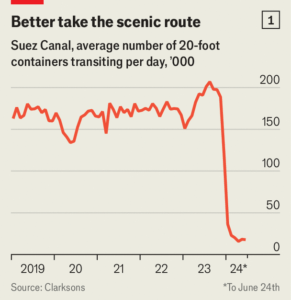
Your browser does not support the <audio> element.
BP AND SHELL, two British oil giants, have long sunk cash into solar and wind farms. Their rivals elsewhere have mostly stuck to their drilling. Investors have rewarded single-mindedness. ExxonMobil, an American firm unapologetically wedded to the black stuff, is worth $510bn, half as much again as the British duo combined. Its share price is up by 50% in the past five years, compared with a rise of 10% for Shell and a fall of 13% for BP.
That is not to say ExxonMobil has no interest in renewables. But rather than getting into generation, it is placing an indirect bet on the energy transition. On June 25th it signed a preliminary agreement to supply lithium to SK On, a South Korean manufacturer whose lithium-ion batteries will power electric Fords and Hyundais. This follows an announcement in November that it was drilling its first lithium well in Arkansas. A “material” part of its $20bn in low-carbon investments between 2022 and 2027 will go to lithium, says Dan Holton, in charge of these projects. By 2030 the company hopes to produce enough lithium to supply 1m electric vehicles (EVs) a year. Darren Woods, its boss, sees lithium as a “high-return” opportunity.
His fellow oil CEOs agree. In June Occidental Petroleum set up a lithium joint-venture with BHE Renewables, a subsidiary of Berkshire Hathaway, a $900bn conglomerate. A month earlier Equinor, the state-owned Norwegian oil firm, unveiled a partnership with Standard Lithium, an American miner. Even the world’s oil colossi, Saudi Aramco and ADNOC of the United Arab Emirates, are taking an interest.
Big oil’s enthusiasm for lithium makes sense. Demand for the stuff is likely to rise as more of the world’s machines go electric. In contrast to running the unfamiliar businesses of solar and wind power, oil firms already have expertise that is useful in lithium mining. Extracting the white metal involves tapping saltwater brine, often underground. This requires careful mapping of reservoirs and precision drilling—skills oilmen have honed over decades of subsurface crude extraction (in which brine also happens to be a common waste product). Even the necessary permits are more akin to those for oil and gas than the still more tedious paperwork associated with tapping seams of ore. Refining the extracted metal is likewise similar to what oil companies do in their petrochemicals businesses.
ExxonMobil, Occidental and Equinor are hoping to juice returns from their lithium ventures with clever technologies to separate lithium ions directly from brine using physical membranes or chemical solvents. This requires less land, water and time than the current method, in which brine is collected in vast evaporation ponds. It is also less polluting. Goldman Sachs, a bank, expects that these innovations could do for lithium what fracking did for oil. Brine accounts for nearly two-thirds of the world’s known lithium resources but so far only 40% of production.
Big miners, for their part, have eschewed big bets on lithium. Their shareholders prefer cash to reinvestment at the moment, and the new technology’s upfront cost is at least a third higher than for the ponds, reckons Goldman Sachs. Specialist lithium producers’ high valuations and wild swings in the metal’s price are another turn-off. Miners that have placed smaller wagers often got their fingers burnt. Rio Tinto completed its $825m purchase of a lithium project in Argentina in 2022. By the following year spending on exploration and evaluation had doubled, from less than $200m to nearly $400m.
In contrast to big dirt, big oil has the profits and the balance-sheets to take on capital-intensive ventures. But does it have the commitment? A quarter of a century before it merged with Mobil in 1999, Exxon dabbled in battery technology after the Arab oil embargo of 1973 frightened the world into considering alternatives to fossil fuels. One of its star researchers at the time was Stanley Whittingham, who went on to share the Nobel Prize in chemistry in 2019 with two other pioneers of lithium-ion batteries. He left Exxon in 1984—around the time that the company threw in the towel on this sort of research. ■
To stay on top of the biggest stories in business and technology, sign up to the Bottom Line, our weekly subscriber-only newsletter.

















